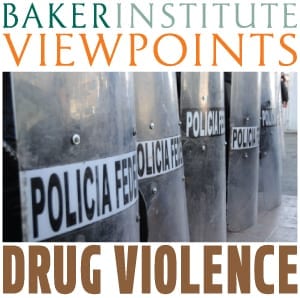As a presidential candidate, Enrique Peña Nieto (PRI) claimed he would bring a new strategy to the country’s struggle with organized crime — one that de-emphasized the targeting of drug kingpins and focused on reducing homicides, extortion cases and kidnappings.
One year into the presidency, Peña Nieto’s administration claims that the homicide rate has dropped by 18 percent; on the other hand, government stats point to a 35 percent increase in kidnappings. After the arrest of two major Zeta and Gulf Cartel leaders earlier this year, Peña Nieto’s strategy shift appears to be more rhetorical than real. Many scholars, analysts and civil society leaders have taken issue with the claim that drug-related violence has declined. Recognizing the importance of understanding drug-related violence in Mexico, Baker Institute Viewpoints invited five scholars to respond to the question, “Has drug violence in Mexico declined?”
Read other posts in this series:
- Perception and intent define the reality, but criminal violence in Mexico has metastasized by Robert Bunker, senior fellow with Small Wars Journal — El Centro
- Measuring mayhem: The challenge of assessing violence and insecurity in Mexico by John Sullivan, lieutenant in the Los Angeles County Sheriff’s Department
- Mexico’s national crime statistics show no significant decline in homicides and disappearances by Molly Molloy, research librarian and border specialist at the New Mexico State University Library
- Mexico must address violence and profitability by Nathan Jones, drug policy fellow at Rice University’s Baker Institute
The expression “perception is reality” has been used in a wide variety of situations, from marital infidelity to psychological operations during wartime. As unfair or unjust as that expression seems to some people, far too often it’s the truth — and Mexico’s drug war is no exception.
Trying to accurately measure crime rates or basic levels of violence in countries where corruption runs rampant can be extremely difficult. The first quantitative measure most analysts turn to is crime statistics, usually collected by local and federal law enforcement agencies and stored and reported by the federal government. While statistics can be manipulated many ways to tell a particular story to fulfill the user’s agenda, reporting methods in the United States are generally reliable and transparent.
However, in a country like Mexico, crime statistics are often wholly unreliable and inconsistent, frequently used to paint a rosier picture of the security situation in areas of the country that have been mired in drug-related violence for years. Adding to the confusion over true levels of crime is the fact that media outlets are often silenced by local drug cartels or criminal gangs. Collecting crime data via open sources can be equally as challenging as accessing accurate official government reports.
Because of these inconsistencies — one example being the reported annual murder rate — drug war observers sometimes have to rely on anecdotal (i.e. subjective) evidence to gauge the levels of security in parts of Mexico. Individuals living in places like Acapulco or Monterrey post about shootouts or narcoblockades on social media outlets. Word of mouth spreads in communities about cousins or uncles or neighbors who have been kidnapped and never heard from again. Crimes go unreported because the police are feared and distrusted.
The Pew Research Center has conducted various surveys in Mexico related to perceptions of security roughly every year. In 2012, the survey found that 75 percent of respondents felt cartel-related violence was a very big problem. Almost 70 percent believed both corrupt political leaders and illegal drugs were a major concern. The numbers for the previous year were mostly similar, although percentage of people who felt overall crime was a major problem dropped seven percentage points from 2011 to 2012.
Mexico’s National Institute of Statistics and Geography (INEGI) carries out their own annual security survey, and the results are similar to those of the Pew Center. The most recent report, published in September 2013, indicated just over 72 percent of respondents felt insecure, up from 67 percent the year before. Those believing various levels of police agencies were corrupt ranged from 65 to 78 percent.
These survey results paint a picture of a population mostly living in a perpetual state of fear and mistrust. However, published crime statistics and statements by Mexican government officials would lead drug war observers to believe the security situation has actually improved since President Enrique Peña Nieto took office in December 2012. During his first State of the Union address, Peña Nieto announced that there had been a 13.7 percent drop in the murder rate between January and August 2013, compared to the same time frame in 2012. He also said that murders linked to organized crime had dropped by 20 percent.
In addition to the drop in murders, Peña Nieto’s administration has also overseen the capture of two major cartel kingpins. In July 2013, Mexican marines captured the notorious Miguel “Z-40” Treviño Morales, head of Los Zetas and one of the most brutal killers in Mexico. The following month, Mexican soldiers captured Mario “X-20” Ramirez Treviño, who had been relatively recently installed as the head of the Gulf cartel.
So is the security situation in Mexico improving? It is in some places and not in others. Both statistical and anecdotal evidence support the assertion that crime levels have gone down significantly in Ciudad Juárez, formerly dubbed “Murder City” and the murder capital of the Western Hemisphere. Although still plagued by crime and kidnappings, violence levels in Tijuana have plummeted since 2010. However, northeastern Tamaulipas state is the site of regular bloodshed between the Gulf cartel and Los Zetas, Coahuila state has retained a steady annual body count, and Jalisco state is heating up more and more with every month that passes.
But the truth is that reality doesn’t really matter. Mexico’s president and governors and mayors can spout declining murder rates all they want, but if the Mexican people don’t trust them or their police officers to keep them safe, then statistics are meaningless. Drug cartels are masters of perception management, using messages on publicly displayed banners and body dumps in highly trafficked areas to propagate fear and insecurity. Regardless of needle movement on the actual murder rate, the perception of violence has remained steady or increased, and that reality is stronger than any that can be forged by numbers on paper.
 Sylvia Longmire is a former Air Force officer and special agent with the Air Force Office of Special Investigations, where she specialized in counterintelligence, counterespionage and force protection analysis. She is also a former senior intelligence analyst for the California State Terrorism Threat Assessment Center, providing daily situational awareness to senior state government officials on southwest border violence and significant events related to the drug war in Mexico. Longmire is regularly interviewed by national, international, and local media outlets, including Fox News, CNN, MSNBC, PBS, BBC News, CBC, and Al Jazeera-English for her knowledge and expertise on border violence issues. Her first book, “Cartel: The Coming Invasion of Mexico’s Drug Wars,” was published in September 2011, and she has written for numerous peer-reviewed journals and online publications. Longmire is currently a consultant and freelance writer.
Sylvia Longmire is a former Air Force officer and special agent with the Air Force Office of Special Investigations, where she specialized in counterintelligence, counterespionage and force protection analysis. She is also a former senior intelligence analyst for the California State Terrorism Threat Assessment Center, providing daily situational awareness to senior state government officials on southwest border violence and significant events related to the drug war in Mexico. Longmire is regularly interviewed by national, international, and local media outlets, including Fox News, CNN, MSNBC, PBS, BBC News, CBC, and Al Jazeera-English for her knowledge and expertise on border violence issues. Her first book, “Cartel: The Coming Invasion of Mexico’s Drug Wars,” was published in September 2011, and she has written for numerous peer-reviewed journals and online publications. Longmire is currently a consultant and freelance writer.
